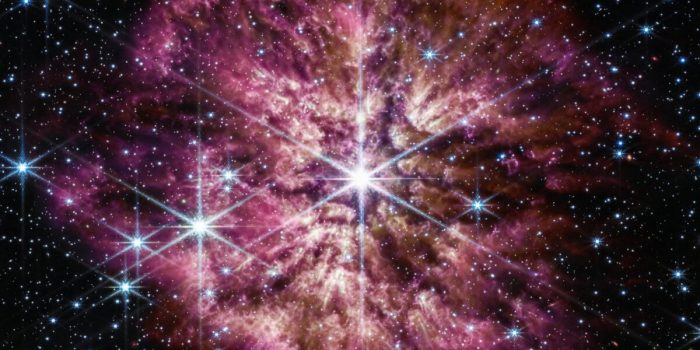On Tuesday, NASA released a breathtaking photo captured by the James Webb Space Telescope, which depicts a massive star teetering on the edge of death and preparing to burst into a supernova. The image shows that the star has been gradually expelling its outer material, creating a tangled, multilayered halo of gas and dust around itself.
As the expelled gas moves further away from the star, it cools and condenses to form a luminous “nebula” that emits a pinkish glow, visible in the infrared camera of the Webb telescope. These ejections serve as a signal that the star is approaching its final explosive act, the supernova.

NASA describes Wolf-Rayet stars as being among the most luminous, massive, and briefly detectable stars in existence. These stars, which are named after astronomers Charles Wolf and Georges Rayet, represent a pre-supernova stage in a star’s life. While some stars experience only a brief Wolf-Rayet phase before dying, this type of star is still considered a rare sight.
One such Wolf-Rayet star, designated as WR 124, is located in the constellation Sagittarius and is situated 15,000 light-years away from Earth. This star is massive, weighing 30 times more than the sun, and has shed an impressive 10 suns’ worth of material, creating a glowing nebula visible from our planet. This cosmic dust is of great interest to astronomers since it serves as the building blocks for everything in the universe, including new stars and planets.
“The universe is operating with a dust budget surplus,” NASA wrote.
As old, dying stars explode and expel dusty material into space, astronomers are left with a great cosmic feat of recycling. According to NASA, the amount of dust in the universe is more than what current theories can explain.
“Before Webb, dust-loving astronomers simply did not have enough detailed information to explore questions of dust production in environments like WR 124, and whether the dust grains were large and bountiful enough to survive the supernova and become a significant contribution to the overall dust budget,” NASA wrote in its release of the photo. “Now those questions can be investigated with real data.”
However, the James Webb Space Telescope, with its powerful infrared capabilities, could provide more clues about the origins of dust by studying supernovas and Wolf-Rayet stars like WR 124. With its superior dust-studying capabilities, the James Webb Space Telescope could unlock the mystery surrounding the origins of cosmic dust.


